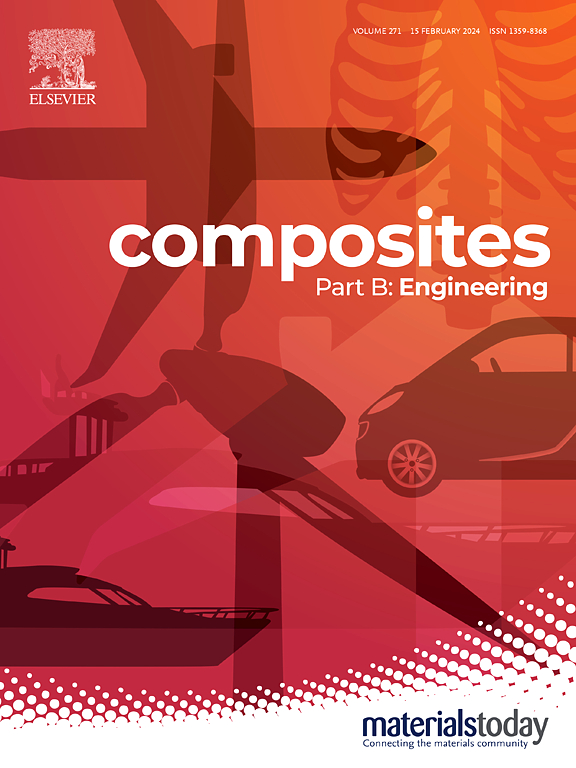Ti2AlNb/7075Al层合金属复合材料非稳态轧制协同变形及界面行为研究
IF 12.7
1区 材料科学
Q1 ENGINEERING, MULTIDISCIPLINARY
引用次数: 0
摘要
Ti2AlNb/7075Al 层状金属复合材料(LMC)在短期高温条件下表现出低密度、高强度和出色的机械性能。它们在宽温度范围内运行的飞机上有着巨大的应用潜力。然而,7075Al 和 Ti2AlNb 在机械性能和加工温度上的显著差异给使用传统制造方法制造 LMC 带来了挑战。因此,本研究提出了一种制造高质量 Ti2AlNb/7075Al LMC 的非稳态轧制方法。界面结合率达到 88%。这些密度为 3 g/cm3 的 LMC 具有优异的机械性能,拉伸强度超过 650 兆帕,伸长率大于 16%。Ti2AlNb 和 7075Al 在 650-700 °C 的 1-3 分钟非稳定热处理过程中实现了精确的强度匹配。在此范围内,7075Al 没有过烧的迹象,其拉伸强度仅降低 25%。同时,Ti2AlNb 不会因 O 相析出而硬化,并表现出优异的塑性。这种出色的机械性能匹配导致两种金属在轧制过程中发生协调变形。少数 Ti2AlNb 晶粒会发生扭结以适应变形。界面附近的 Ti2AlNb 层形成了浅的矩形撕裂间隙,这些间隙被 7075Al 填满,形成了牢固的机械互锁。同时,快速轧制过程可防止在界面处形成脆性产物。在 Ti2AlNb/7075Al LMC 的界面上可以观察到原子尺度的结合。本文章由计算机程序翻译,如有差异,请以英文原文为准。

Study on unsteady rolling cooperative deformation and interface behavior of Ti2AlNb/7075Al laminated metal composites
Ti2AlNb/7075Al laminated metal composites (LMCs) exhibit a low density, high strength, and outstanding mechanical properties under short-term elevated temperatures. They hold significant potential for application in aircraft operating across wide temperature range. However, the significant differences in mechanical properties and processing temperature between 7075Al and Ti2AlNb present challenges for fabricating LMCs using conventional manufacturing methods. Therefore, this study proposes an unsteady rolling method for fabricating the high-quality Ti2AlNb/7075Al LMCs. The interfacial bonding rate reaches 88 %. These LMCs with a density of 3 g/cm3 demonstrate excellent mechanical properties, achieving a tensile strength exceeding 650 MPa and an elongation greater than 16 %. Precise strength matching between Ti2AlNb and 7075Al is achieved during unsteady heat treatment at 650–700 °C for 1–3 min. Within this range, 7075Al shows no signs of over-burning and its tensile strength decreases by only 25 %. Meanwhile, Ti2AlNb does not experience hardening caused by O-phase precipitation and demonstrates excellent plasticity. This excellent mechanical property matching results in coordinated deformation of the two metals during the rolling process. A few Ti2AlNb grains undergo kinking to accommodate the deformation. The Ti2AlNb layer near the interface forms shallow rectangular tear gaps, which are filled by 7075Al, creating a strong mechanical interlocking. Meanwhile, the rapid rolling process prevents the formation of brittle products at the interface. Atomic scale bonding is observed at the interface of the Ti2AlNb/7075Al LMCs.
求助全文
通过发布文献求助,成功后即可免费获取论文全文。
去求助
来源期刊

Composites Part B: Engineering
工程技术-材料科学:复合
CiteScore
24.40
自引率
11.50%
发文量
784
审稿时长
21 days
期刊介绍:
Composites Part B: Engineering is a journal that publishes impactful research of high quality on composite materials. This research is supported by fundamental mechanics and materials science and engineering approaches. The targeted research can cover a wide range of length scales, ranging from nano to micro and meso, and even to the full product and structure level. The journal specifically focuses on engineering applications that involve high performance composites. These applications can range from low volume and high cost to high volume and low cost composite development.
The main goal of the journal is to provide a platform for the prompt publication of original and high quality research. The emphasis is on design, development, modeling, validation, and manufacturing of engineering details and concepts. The journal welcomes both basic research papers and proposals for review articles. Authors are encouraged to address challenges across various application areas. These areas include, but are not limited to, aerospace, automotive, and other surface transportation. The journal also covers energy-related applications, with a focus on renewable energy. Other application areas include infrastructure, off-shore and maritime projects, health care technology, and recreational products.
 求助内容:
求助内容: 应助结果提醒方式:
应助结果提醒方式:


